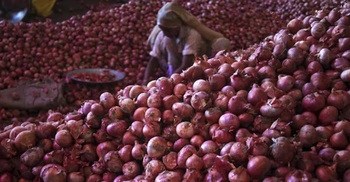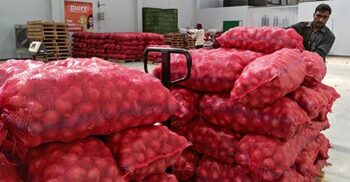Unstable Onion Market: Where will the price stop?

The soaring price of onions is creating significant hardships for people with limited incomes. Currently, one kilogram of onions costs between Tk 110 and Tk 120, marking a Tk 20 increase in just the past week and doubling in price over the last month and a half.
This price spike comes despite the end of the full onion season a few months ago, and despite sufficient supplies of native onions still being available. With the next onion season six to seven months away, the pressing question for consumers is where the price of this essential commodity will go next.
Unfortunately, no one seems to have an answer. In recent years, Bangladesh has experienced recurring spikes in onion prices. In 2019, onions had to be imported by cargo plane during a shortage, but even then, prices remained high, reaching Tk 250 per kilogram.
In this context, the Ministry of Commerce has yet to take decisive action to control the rising prices of onions.
Maleka Khairunnesa, head of the ministry's Import and Internal Trade (IIT) Division, stated that while discussions are ongoing, no final decisions have been made about reducing onion prices, increasing imports from India, or sourcing onions from alternative countries.
Since 2019, the end-of-season price instability for onions has become an annual occurrence, usually peaking in November-December. This year, however, the instability has begun earlier, raising concerns among consumers about where prices will stand in the coming months.
Traders warn that without timely intervention, onion prices could surpass all previous records. Historically, when onion prices increased domestically, the market stabilised through imports from India
However, this year, onion production in India has decreased, leading to higher prices there as well. India initially halted onion exports due to low production but later resumed with increased duties. Currently, importing onions from India costs about Tk 90 per kilogram, making it an unviable option for many importers. In India minimum export price of onion is $550 per tonne and the importers need to pay 40 per cent duty.
Farmers too have low onion stock
Farmers in Bangladesh also have low stocks of onions. Due to high prices earlier this year, many farmers harvested and sold their onions early, affecting overall production. During March-April, prices of onion was much higher than the peak season.At that time, price of onion was high in the market which benefited the farmers but left impact on total production. As a result, control of the onion market has shifted to hoarders.
Pabna is a leading district in onion production. The onions there are available throughout the year in different parts of the country. Manik Hossain, a farmer of Sujanagar in the district, cultivated 300 maunds of onions on five bigha land and sold them at the beginning of March. Which would have exceeded about 500 maunds when matured. Then he got the price of about Tk 3,500 per maund.
Manik told Jago News that during the peak season of other years, the price of onion remains around Tk 1,500 per maund. This time it was more than double. As the price is good, I bought it earlier and sold it. Profits have been good despite lower yields.
Not only Manik Hossain, several farmers reported similar information. Last March too most of the farmers sold onions due to high onion prices.
What will happen in November-December?
The Spice Research Center of the Department of Agricultural Extension, which focuses on onion production in Bangladesh, foresees potential trouble ahead. Chief Scientific Officer Shailendranath Majumdar explained to Jago News that Bangladesh typically experiences the greatest onion shortage from September to December. Currently, the market is already showing signs of instability, and the situation is likely to worsen during this period.
Majumdar highlighted that the bulk of the country’s onion production occurs between March and April. During this time, farmers bring home 80 per cent of the total domestic onion production, which keeps prices relatively low for the following few months. There are also spring onions harvested in January-February and a small amount of summer onions in June-July, but these do not significantly impact overall supply.
As a result, the market experiences a shortage from September until January, before the new harvest comes in. During this time, farmers typically have no stock left, while hoarders hold onto onions, creating an artificial shortage to drive up prices.
Abdul Majed, a trader and importer from Dhaka's Shyambazar, told Jago News that without immediate and effective measures, onion prices could surpass all previous records. Consumers might face abnormally high prices for onions if the situation is not addressed promptly.
No option but to import
With a significant shortfall in onion production this year, the market is tightening before the end of the season. Dr. Shailendranath Majumdar believes that importing onions is the only viable solution to stabilise the market. He explained that while the country’s annual onion demand is primarily met through domestic production, the deficit is usually covered by imports, mostly from India. However, with India increasing its export prices, onions now have to be imported from countries like Myanmar, Egypt, Turkey, and China.
The import situation is complicated. India has halted exports to all but six neighbouring countries, causing a global price increase. Additionally, India has produced around 3.5 million tonns less onion this year, further driving up prices.
Myanmar, another potential exporter, is currently at war, making imports from there unfeasible. Traders are also hesitant to import onions from countries like Turkey and Egypt due to past financial losses. In 2019, importers faced significant losses when onions worth crores of taka went unsold and rotted.
Abdul Majed, an importer from Dhaka's Shyambazar, said importing from Myanmar would be ideal after India, but the ongoing war makes this impossible. He noted that importing onions from Egypt and Turkey in 2019 resulted in substantial losses, with many onions going unsold and rotting. No one is willing to take that risk again.
Majed emphasised that onion prices are unlikely to decrease this time, as production has dropped more than official figures suggest. As a result, consumers will have to pay higher prices. Most Bangladeshi importers prefer importing from India because it's easier and cheaper by road. Even when options to import from other countries exist, they are often not pursued.
In 2019, the government requested major industrial groups to import onions to address the crisis, resulting in onions being flown in by cargo planes.
Gokul Krishna Manik, another importer from Shyambazar, explained that importing from Egypt or Turkey would require shipping, significantly increasing costs and spoilage risk due to the long transit time. Additionally, cargo fares have increased, making imports even more expensive. The taste and size of onions from these countries also differ, and consumers are reluctant to buy them at high prices.
Manik stressed that with India's high export prices and associated customs and VAT, importing from India is also not feasible. He called for the government to take serious steps to facilitate onion imports from India; otherwise, the crisis will only worsen.
Inconsistent demand and production figures
Accurate data on onion demand and production in Bangladesh is lacking, with various organisations providing differing figures. Agriculture-related entities report increased production and lower demand, while the Bangladesh Bureau of Statistics (BBS) indicates that demand exceeds production.
According to the Directorate of Agricultural Marketing, the annual demand for onions in the country is approximately 3 million tonnes, with one-third needing to be met through imports. However, the Department of Agricultural Extension reports that onion production in the fiscal year 2023-24 is about 3.4 million tonnes, slightly down from 3.5 million tonnes the previous year. This data suggests that domestic production should suffice to meet demand, indicating no shortage in the market.
Contrary to these figures, import and market data tell a different story. Bangladesh imports 7 to 8 lakh tonnes of onions annually, making it the world's largest importer of onions. This discrepancy highlights issues with the production and demand statistics provided by domestic agencies.
The Food and Agriculture Organization (FAO) ranks Bangladesh seventh in global onion production. Despite this high production level, domestic output fails to meet the country’s demand, resulting in increased imports. This import volume has risen so significantly that Bangladesh now tops the global list of onion importers.
Traders attribute the increase in onion consumption to rising incomes and greater demand for processed foods. As people's incomes grow, so does their onion consumption. The country’s annual onion demand is about 4 million tonnes, which local production cannot satisfy, necessitating substantial imports.
NH/NMA







